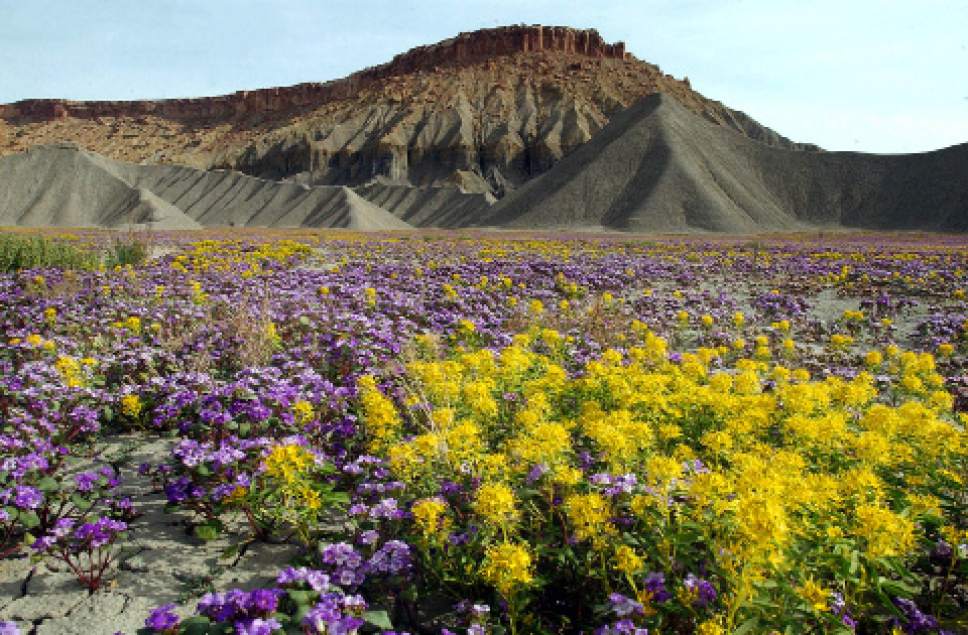This is an archived article that was published on sltrib.com in 2017, and information in the article may be outdated. It is provided only for personal research purposes and may not be reprinted.
A state judge has invalidated a conditional-use permit Wayne County officials issued for a gravel pit on state trust lands on the edge of Teasdale, raising new questions on how much say local governments have over projects authorized by the Utah School and Institutional Trust Lands Administration.
The county last year approved a gravel pit on part of a 120-acre SITLA parcel just upwind from Torrey, the artsy gateway to Capitol Reef National Park, in an area zoned for agriculture and low-density residential. The move outraged some residents, who took the dispute to court.
A group calling itself Friends of Red Rocks argued a gravel-mining pit in that location risked making a mockery of Wayne County's zoning ordinance and would subject Torrey to dust driven off the pit by stiff westerly winds.
But 6th District Judge George Harmond ruled that state-owned land is exempt from county zoning rules, so Wayne County properly declined to "rezone" the parcel in question. At the same time, Harmond said in his ruling the conditional-use permit issued to Brown Brothers Construction to operate the pit is not valid — since such permits are premised on a zoning designation.
"The counties cannot regulate conditional uses with a nonexistent zone," the judge wrote. The county's permit "is, then, of no force or effect."
Bill Barrett, a spokesman for Friends of Red Rocks, said the ruling seems to assert that counties cannot impose conditions on businesses operating on SITLA land and that Brown only needs SITLA's approval to move forward with its sand-and-gravel operation.
"Because the county doesn't have the right to rezone, the county has no role," Barrett said. "... We are left with the situation where everything is in SITLA's hands."
Local control over projects proposed on state trust lands has become a hot topic in light of a number of SITLA development prospects around the state, including a 5,000-home subdivision in Rush Valley, a luxury destination in Moab and an oil field near Bluff.
Earlier this year, the Teasdale gravel pit controversy spurred Rep. Mike Noel, R-Kanab, to sponsor legislation to ensure SITLA's zoning exemption also applied to those issued SITLA permits or leasing SITLA land. At the time, SITLA Executive Director David Ure told a legislative panel that those doing business on state trust lands sometimes run into residents who use zoning rules to block "any kind of growth at any time in any shape or form."
While Ure saw Noel's HB408 as a remedy, the Utah League of Cities and Towns denounced it as "shortsighted" measure that would undermine SITLA's mission to raise revenue to support schools.
"If this bill passes, SITLA can do whatever it wants," Rep. Merrill Nelson, R-Grantsville, told fellow lawmakers. "SITLA will remain beyond any control of the local people. Any planning, zoning requirement will be out the window. This creates a serious problem for local government."
HB408 barely passed the House then died without a hearing in the Senate.
SITLA, whose mission is to maximize revenues from state trust lands, makes a practice of insisting its lessees obtain zoning changes and conditional-use permits from local authorities. Harmond's ruling may suggest SITLA lacks authority to submit itself to municipal land-use ordinances even if it wanted to.
"The unintended consequences could be really serious here," Barrett said.
He and others said they also are concerned that county authorities now have no way to impose conditions on industrial operations on trust lands in their jurisdictions, even if those operations clash with surrounding land uses.
SITLA general counsel John Andrews declined to discuss the ruling Monday, saying he was seeking to meet with parties in the case, including Wayne County and Brown Brothers.
Brown Brothers has reportedly exhausted an existing quarry in Loa and is seeking another source of gravel for upcoming road projects. Members of Friends of Red Rocks located a SITLA parcel near Bicknell as an alternative gravel source, but company officials turned it down, Barrett said, because its gravel wasn't as concentrated and it held possible archaeological sites that would have to be surveyed.
Meanwhile, nearby business operator Dave Van Dyke has asked SITLA to put the Teasdale parcel up for sale at its twice-yearly auction this fall. Van Dyke's family operates the Red River Lodge and holds grazing permits on the parcel.
Barrett argued a sale would generate far more revenue for SITLA.
Once in private hands, the land would presumably fall under Wayne County zoning rules.
Brian Maffly covers public lands for The Salt Lake Tribune. Brian Maffly can be reached at bmaffly@sltrib.com or 801-257-8713.
Twitter: @brianmaffly



